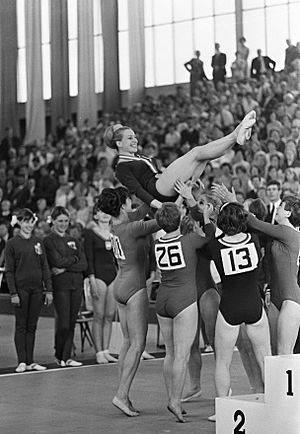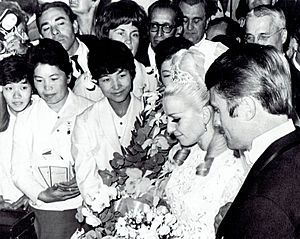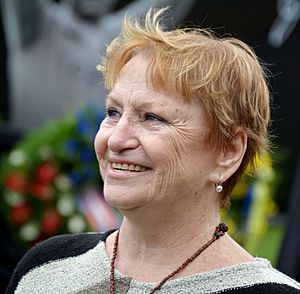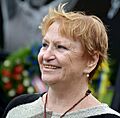Věra Čáslavská facts for kids
Quick facts for kids Věra Čáslavská |
||||||||||||||||||||||||||||||||||||||||||||||||||||||||||||||||||||||||||||||||||||||||||||||||||||||||||||||||||||
|---|---|---|---|---|---|---|---|---|---|---|---|---|---|---|---|---|---|---|---|---|---|---|---|---|---|---|---|---|---|---|---|---|---|---|---|---|---|---|---|---|---|---|---|---|---|---|---|---|---|---|---|---|---|---|---|---|---|---|---|---|---|---|---|---|---|---|---|---|---|---|---|---|---|---|---|---|---|---|---|---|---|---|---|---|---|---|---|---|---|---|---|---|---|---|---|---|---|---|---|---|---|---|---|---|---|---|---|---|---|---|---|---|---|---|---|---|

Čáslavská at the 1967 European Championships
|
||||||||||||||||||||||||||||||||||||||||||||||||||||||||||||||||||||||||||||||||||||||||||||||||||||||||||||||||||||
| Personal information | ||||||||||||||||||||||||||||||||||||||||||||||||||||||||||||||||||||||||||||||||||||||||||||||||||||||||||||||||||||
| Full name | Věra Čáslavská | |||||||||||||||||||||||||||||||||||||||||||||||||||||||||||||||||||||||||||||||||||||||||||||||||||||||||||||||||||
| Nickname(s) | Japanese: 「東京の恋人」 English: the love of Tokyo Japanese: 「オリンピックの名花」 English: darling of the Olympic Games |
|||||||||||||||||||||||||||||||||||||||||||||||||||||||||||||||||||||||||||||||||||||||||||||||||||||||||||||||||||
| Country represented | Czechoslovakia | |||||||||||||||||||||||||||||||||||||||||||||||||||||||||||||||||||||||||||||||||||||||||||||||||||||||||||||||||||
| Born | 3 May 1942 Prague, Protectorate of Bohemia and Moravia |
|||||||||||||||||||||||||||||||||||||||||||||||||||||||||||||||||||||||||||||||||||||||||||||||||||||||||||||||||||
| Died | 30 August 2016 (aged 74) Prague, Czech Republic |
|||||||||||||||||||||||||||||||||||||||||||||||||||||||||||||||||||||||||||||||||||||||||||||||||||||||||||||||||||
| Height | 1.60 m (5 ft 3 in) | |||||||||||||||||||||||||||||||||||||||||||||||||||||||||||||||||||||||||||||||||||||||||||||||||||||||||||||||||||
| Weight | 58 kg (128 lb) | |||||||||||||||||||||||||||||||||||||||||||||||||||||||||||||||||||||||||||||||||||||||||||||||||||||||||||||||||||
| Discipline | Women's artistic gymnastics | |||||||||||||||||||||||||||||||||||||||||||||||||||||||||||||||||||||||||||||||||||||||||||||||||||||||||||||||||||
| Years on national team | ~1958–68 (TCH) | |||||||||||||||||||||||||||||||||||||||||||||||||||||||||||||||||||||||||||||||||||||||||||||||||||||||||||||||||||
| Retired | 1968 | |||||||||||||||||||||||||||||||||||||||||||||||||||||||||||||||||||||||||||||||||||||||||||||||||||||||||||||||||||
|
Medal record
|
||||||||||||||||||||||||||||||||||||||||||||||||||||||||||||||||||||||||||||||||||||||||||||||||||||||||||||||||||||
Věra Čáslavská (born May 3, 1942 – died August 30, 2016) was an amazing gymnast from Czechoslovakia. Later, she became a sports official in the Czech Republic. She won a total of 22 international titles between 1959 and 1968. These included seven Olympic gold medals, four world titles, and eleven European championships.
Čáslavská is the most successful Czech gymnast ever. She is also one of only two female gymnasts to win the all-around gold medal at two Olympic Games in a row. The other gymnast was Larisa Latynina from the Soviet Union. Věra Čáslavská is the only gymnast, male or female, to have won an Olympic gold medal in every individual gymnastics event.
Besides her incredible gymnastics skills, Čáslavská was known for speaking out. She supported a movement in Czechoslovakia that wanted more freedom and democracy. She was against the Soviet-led invasion of Czechoslovakia in 1968. At the 1968 Summer Olympics in Mexico City, she showed her protest to the world. She quietly looked down and away when the Soviet national anthem played during medal ceremonies. This happened for the balance beam and floor exercise events.
Many people in her home country admired Čáslavská's actions. However, the new government saw her as an "unwanted person." She was forced to stop competing. For many years, she was not allowed to travel, work, or even attend sports events.
Čáslavská's situation got better in the 1980s. Important people from the International Olympic Committee helped her. After the Velvet Revolution in 1989, when communism ended, her life changed a lot. In the 1990s, she held important jobs. She even became the president of the Czech Olympic Committee.
Contents
Věra Čáslavská's Gymnastics Journey
Věra Čáslavská was born in Prague. She started out as a figure skater before becoming a gymnast. Her first international competition was in 1958 at the World Artistic Gymnastics Championships. There, she won a silver medal with her team.
She won her first individual international title the next year. This was at the European Gymnastics Championships. She took home a gold medal on the vault and a silver on the balance beam. She competed in her first Olympic Games in 1960. Her team won a silver medal there. In 1961, she won a bronze medal in the all-around event at the European Championships.
In 1962, she competed for the all-around title at the World Championships in her home country. She was just barely beaten by Larisa Latynina. However, Čáslavská did win her first world title in the vault event. She did not compete at the European Championships in 1963.
Winning Many Gold Medals (1964-1968)
Between 1964 and 1968, Čáslavská won 19 individual gold medals at major international competitions. She was at her best at the 1964 Summer Olympics in Tokyo. She won the overall title, which is the all-around gold medal. She also won gold medals on the balance beam and the vault. Her team won another silver medal.
At the 1966 World Championships, Čáslavská won the vault title again. Her team also won a gold medal, which was a big deal because it broke the Soviet team's winning streak. She also became the all-around world champion. Čáslavská was amazing at the 1965 and 1967 European Championships. She won all five individual titles at both events. In 1967, she even scored perfect scores of 10.
Training and Protest at the 1968 Olympics
Before the 1968 Summer Olympics in Mexico City, Čáslavská faced a big challenge. The Soviet-led invasion of Czechoslovakia meant she lost her training gym. So, she trained in the forests of Moravia. She used potato sacks for weights and logs for balance beams. She was only allowed to travel to Mexico City at the last minute.
Even with these difficulties, she was outstanding at the 1968 Olympics. She won medals in all six events. She defended her all-around title, winning gold again. She also won gold medals on the floor, uneven bars, and vault. She earned two silver medals for the team competition and the balance beam.
As of the 2020 Olympic Games, Čáslavská and Larisa Latynina are the only female gymnasts to win the individual all-around gold medal in two Olympics in a row. Čáslavská is also the only female gymnast to win the vault gold medal twice in a row. She became very popular with the Mexican crowd. This was partly because she used the "Jarabe tapatío" (a Mexican folk dance tune) for her floor routine. Also, she got married in Mexico City during the Games.
Why Věra Čáslavská Protested
Čáslavská's wins at the 1968 Olympics were very important because of the political problems in Czechoslovakia. She had openly spoken against Soviet-style communism and the Soviet invasion. She had signed a protest letter called "Two Thousand Words" in 1968. Because of this, she had to hide in a mountain town to avoid being arrested before the Olympics.
At the Olympics, Čáslavská competed against Soviet gymnasts. She continued to show her feelings in a quiet way. In the floor exercise, it looked like she had clearly won the gold medal. But then, the judges strangely raised the scores of Soviet gymnast Larisa Petrik. They then said both gymnasts tied for the gold. This happened after another controversial judging decision on the balance beam. That decision cost Čáslavská the gold, giving it to Soviet rival Natalia Kuchinskaya.
Čáslavská was clearly upset by these decisions, which seemed to favor the Soviet Union. So, during both medal ceremonies, she protested. She quietly turned her head down and away when the Soviet national anthem was played.
Life After Gymnastics
The people of Czechoslovakia loved Čáslavská for her brave protest. She was given the Czechoslovakia's Sportsperson of the Year award in 1968. She had won this award four times. However, the sports authorities were not happy with her.
Because she supported the democracy movement (called the "Prague Spring") and protested the Soviet invasion, she was punished. She was not allowed to travel outside Czechoslovakia or take part in public sports events. Čáslavská was forced to retire from gymnastics. She was considered an "unwanted person" in her own country for many years.
The government would not publish her autobiography (her life story). When it was released in Japan, they insisted it be heavily censored. She was allowed to work as a coach in Mexico. This reportedly only happened after the Mexican government threatened to stop selling oil to Czechoslovakia. In the late 1980s, the president of the International Olympic Committee, Juan Antonio Samaranch, helped her. He had given her the Olympic Order. After his help, Čáslavská was finally allowed to work as a gymnastics coach and judge in her home country.
After the fall of Communism in November 1989, Čáslavská's life improved greatly. She became an advisor to President Václav Havel on sports. She also became the Honorary President of the Czech-Japan Association. Later, she was elected President of the Czech Olympic Committee. In 1995, she joined the IOC membership committee.
Gymnastics Skills Named After Her
Věra Čáslavská has one gymnastics skill named after her in the official "Code of Points." This is a book that lists and describes all gymnastics skills.
| Apparatus | Name | Description | Difficulty |
|---|---|---|---|
| Uneven bars | Čáslavská | From front support on high bar - swing backward with release and 1/1 turn (360°) to hang on high bar | C |
Awards and Recognition
Čáslavská received many awards for her amazing contributions to gymnastics. Besides the Olympic Order, she was given a 1989 Pierre de Coubertin International Fair Play Trophy by UNESCO. At the ceremony, she was praised for her "exemplary dignity." In 1995, she received the Medal of Merit from the Czech Republic.
She was added to the International Women's Sports Hall of Fame in 1991. In 1998, she joined the International Gymnastics Hall of Fame. In 2010, she received the Order of the Rising Sun, a high honor from Japan. The Japanese emperor also gave her a 17th-century katana (a type of sword) and a ceremonial kimono.
In 2014, she received the Hanno R. Ellenbogen Citizenship Award. This award is given for outstanding civic courage. An asteroid (26986) Caslavska is named after her.
Personal Life and Later Years
Just before the 1968 Olympics ended, Čáslavská married runner Josef Odložil. He had won a silver medal at the 1964 Summer Olympics in Tokyo. Their wedding took place at the Mexico City Cathedral and thousands of people came to watch. They had a daughter named Radka and a son named Martin. The couple divorced in 1987.
Later, Čáslavská faced a very difficult time. She became depressed and was rarely seen in public for about 15 years. Eventually, she overcame her depression. She returned to public life and sports, even coaching younger gymnasts.
In 2015, Čáslavská was diagnosed with pancreatic cancer. Her health got much worse in the summer of 2016. She was taken to a hospital in Prague on August 30, where she passed away at the age of 74.
Images for kids
See also
 In Spanish: Věra Čáslavská para niños
In Spanish: Věra Čáslavská para niños





